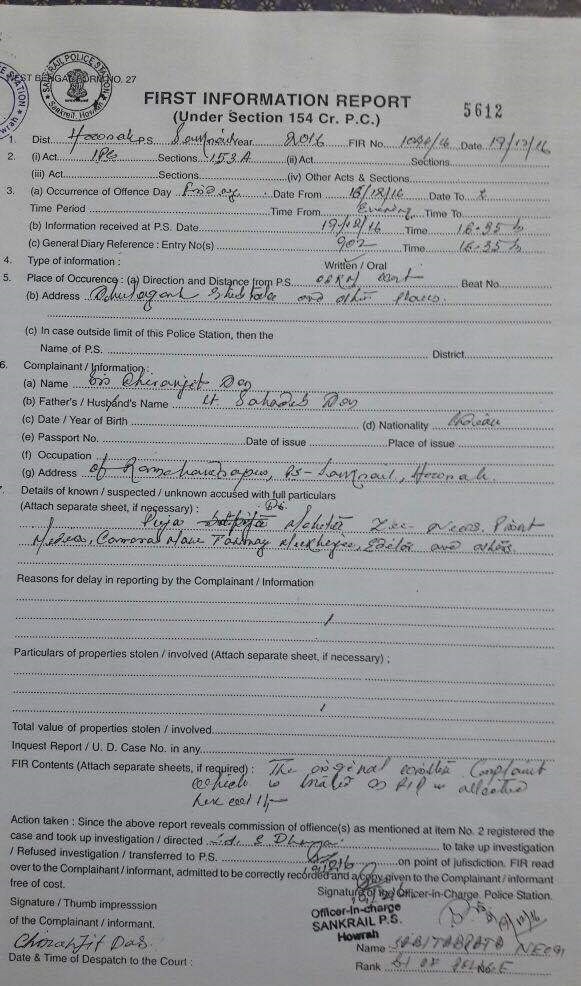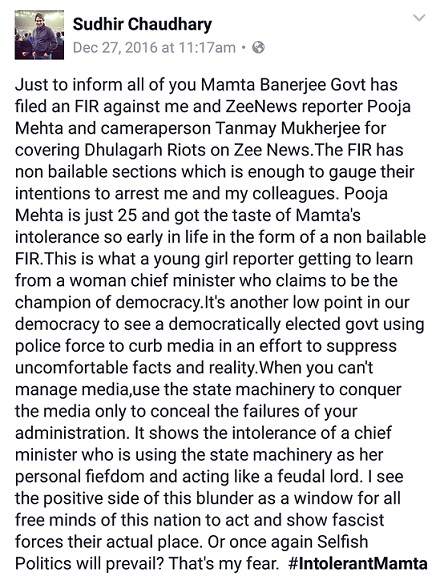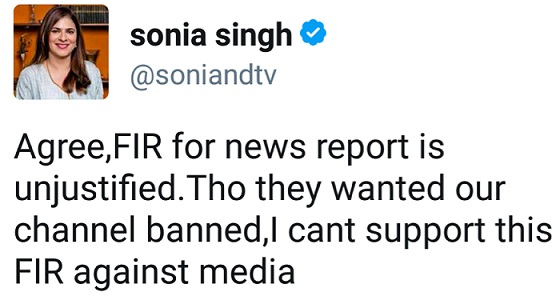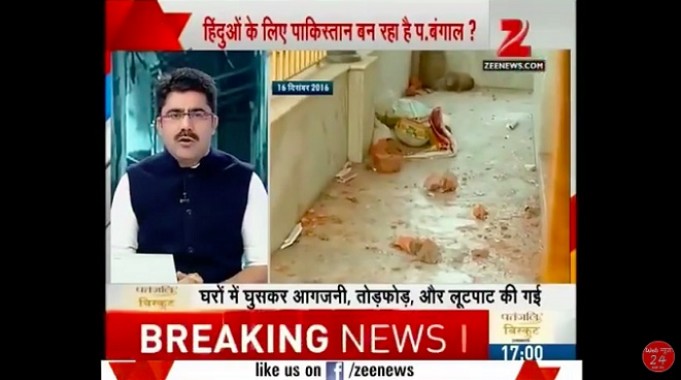Why NDTV ban and Zee FIR are not comparable
Rohit Sardana presenting his show.
On December 19, the West Bengal government filed a FIR against Zee News editor, Sudhir Chaudhary, its West Bengal correspondent, Pooja Mehta, and cameraperson Tanmay Mukherjee for their coverage of the Dhulagarh riots last month in Howrah district of the state. The charges against them - promoting enmity between different groups on grounds of religion, race or place of birth etc. - are non-bailable.

Zee News, in its reporting on the Dhulagarh riots, especially the show ‘Taal Thok Ke’ by anchor Rohit Sardana, crossed all limits. Sardana compared Bengal to Pakistan and kept praising BJP spokesman Sambit Patra (one of the panelists on the show) for mentioning ‘Hindu’ in place of ‘dharm vishesh’. Professor Manojit Mandal, representing the ruling Trinamool Congress, kept requesting the anchor not to convert a law and order issue into a communal one.
The word secularism was turned into a joke. Parties opposed to the BJP were criticized for hyping the 2015 Dadri mob lynching while not criticising Malda or Dhulagarh because Sardana believes these parties indulge in minority appeasement politics. RSS ideologue Rakesh Sinha, another panelist, compared West Bengal Chief Minister Mamata Banerjee to Lord Curzon and accused her of communal polarization. The whole thrust of the programme was propagating hatred against Muslims and serving Hindutva propaganda.
The day the FIR was lodged, Sudhir Chaudhary announced it on social media platforms. He introduced his fellow reporter Pooja Mehta by her age, ‘Pooja Mehta is just 25 and got the taste of Mamta's intolerance so early in life in the form of a non bailable FIR’.Introducing a colleague by her age and not by her credentials ridicules her professionalism.

His supporters took up the fact that while everyone had opposed the recent proposed ban against NDTV by the Information & Broadcasting Ministry, the lodging of a FIR against Zee journalists was an act of intolerance that was not being criticised. Chaudhary’s followers started tweeting with #ISupportSudhirSir.
Sudhir Chaudhary has to be credited for taking up the issue of Dhulagarah when most of the media houses seemed to be practising self censorship. Deepanjana Pal in this report published in Newslaundry mentions this and correctly points out that media failed people. People left messages like “Dada aashoon, amader baachan (Dada, please come and save us)!” for reporters whose contacts they had, but the reporters were unsure if it would be responsible to carry any story on it. It is their failure which created an opportunity for propagandist channels like Zee to convert Dhulagarh into an easy binary of a community vs the other. When this happens the audience begins to lose confidence in media and buys into by the narratives provided by Zee.
I had been very vocal against the NDTV ban but hardly wrote anything on the FIR lodged against Zee except sharing a DailyO article on the Dhulagarh riots. The article explained in depth how the BJP tried to paint the whole incident in communal colours. It said Zee News helped the BJP in this hate-mongering. The West Bengal BJP appealed to its Twitter followers to trend #BengalInFlames. However, the people of West Bengal and local reporters tried their level best to quell the rumours and maintain the peace.
In the media, one needs to be understand why events are sometimes covered or not covered or to what extent, but the big question is different: Is a media house allowed to incite hatred or align with a political party and favour a particular religious community and ensure its safety at the cost of the safety of another religious community?
Not writing on the FIR on Zee was not because of antipathy to their ideology or some sort of ‘convenience of silence’. As a student of journalism, I have been taught ‘objectivity’, ‘never distort the facts’, ‘become the voice of the marginalised’, ‘never incite violence’, ‘avoid sensational news’, ‘stand against the unjust’, and ‘do not become a judge’.
I find that Sudhir Chaudhary and Zee have failed on all these parameters. Odd how Chaudhary and I are both alumni of the Indian Institute of Mass Communication but have turned out to practise two totally different forms of journalism. Just a reminder, it was Chaudhary, who was then CEO of the Live India channel, who aired a sting on Delhi government school teacher Uma Khurana which claimed that she was forcing students into prostitution. This turned out to be false but the damage to Khurana’s image was done.
Post-truth and the media
The Oxford Dictionary declared ‘post-truth’ as the Word of the Year in 2016 but elements of this phenomenon could be seen in the Indian media much earlier in channels like Zee News and in the coverage of right wing extremism. Take the example of the events at JNU in February. The way the incident was reported in the mass media was absurd. Forensic teams found a few of the videos shot by Zee to be doctored. Slogans were inserted in the original video but it went on air and a nationwide anti-JNU campaign was bolstered by the video. It was clear by the end of 2012 and by the 2014 general election that Zee was working hand-in-glove with the BJP.
Zee owner, Subhash Chandra, in his book The Z Factor: My Journey As The wrong Man At The Right Time (the book was inaugurated by Prime Minister Modi last year) provides insights into the editorial and working policy of Zee Media. Chandra mentions that when Samir Ahluwalia (then Zee Business head) and Sudhir Chaudhary were trapped in a Rs 100 crore extortion bid by businessman and Congress politician Naveen Jindal in 2012, the Congress Party did not help Chandra out. “This was an unjust act by the UPA. In response, I personally supported Narendra Modi’s campaign for prime ministership,” writes Chandra on page 264.
Zee has been reporting on the ‘Hindu exodus’ in Kairana and Malda, creating a binary over Akhlaq’s mob lynching and Bajrang Dal activist Prasanth Pujari’s murder in Karnataka, and over the recent Bhopal jail break encounter involving SIMI activists (Zee ‘declared’ them terrorists at once). Chandra’s channel has put all its efforts into framing Muslims and dividing audiences in the name of pseudo nationalism.
It should be made clear that the proposed ban on NDTV had a different context and was subjective in nature. The FIR against Chaudhary and his colleagues, by contrast, is aimed at alleviating a problem which could intensify Hindu-Muslim clashes. The former was an attempt to muzzle free speech. The latter is a sharp reminder to Zee to stick to media ethics. Therefore, these two developments cannot be seen as synonymous.
The primary principle of journalism – that the facts are sacred - requires the media to be very careful while reporting on sensitive issues rather adding fuel to the fire which is what Zee News sought to do.
Meanwhile the owner of Zee Media Subhash Chandra should look back at those tweets in which he demanded a life long ban on NDTV. He should be thankful to Ndtv Editorial Director Sonia Singh who inspite of channel rivalry believes that the FIR on Zee is an unjust act.

Supporting links:
1. http://www.newindianexpress.com/nation/2016/dec/27/zee-news-booked-for-dhulagarh-riot-coverage-claims-editor-sudhir-chaudhary-1553567.html (Zee booked for Dhulagarh Riots)
2. http://www.dailyo.in/politics/bjp-west-bengal-mamata-banerjee-mohan-bhagwat-bengal-in-flames-tapan-ghosh-hindu-sammati-dhulagarh-howrah/story/1/14652.html (DailyO’s full length article which I shared.)
3. http://indiatoday.intoday.in/story/forensic-experts-say-kanhaiya-video-wasdoctored/1/600808.html (Kanhaiya’s videos doctored)
4. http://www.ndtv.com/india-news/2-videos-of-jnu-event-manipulated-finds-forensic-probe-sources-1283105 (hate words inserted in the video)
5. http://www.hindustantimes.com/india/two-out-of-seven-videos-on-jnu-were-doctoredsays-forensic-test/story-DT4jVdL4AUDSGdPI1cOq8N.html (two out of seven videos doctored)
6. https://www.youtube.com/watch?v=r8seZLhzMNQ (Uma Khurana’s fake sting)
7. https://www.youtube.com/watch?v=SIO5O9gYYrA (Zee reporting on ‘Hindu-exodus’in Kairana)
8. https://www.youtube.com/watch?v=8QH7lMa5JuE (Zee reporting on Malda mob voilence)
9. https://www.youtube.com/watch?v=Lz3s1GHNdiM (Zee report creating binary over Akhlaq’s mob lynching and Prasanth Poojary’murder)
10. https://www.youtube.com/watch?v=CJf3YfvgEZ4 (Zee report on Akhlaq’s mob lynching. Zee maintained systematic silence and report was done a later after Aklaq’s death)
11. https://www.youtube.com/watch?v=seubKKs6xjw (Zee puts forward a case for eco-friendly Bakri-Eid,targeting a particular community)
12. https://www.youtube.com/watch?v=lcAKWu2LkPE (SIMI ‘terrorists’ encountered)
13. https://www.youtube.com/watch?v=z8Gu5ZF63Wg (Dhulagarh Riot reporting by Zee)
14. https://www.youtube.com/watch?v=yEfSxXJk_94 (Dhulagarh Riot reporting by Zee -2, the anchor compares Bengal to Pakistan)
(Dhulagarh reports have been removed from Zee News YouTube channel after the FIR was registered).
Rohin Verma is a student at the Indian Institute of .Mass Communications in Delhi







